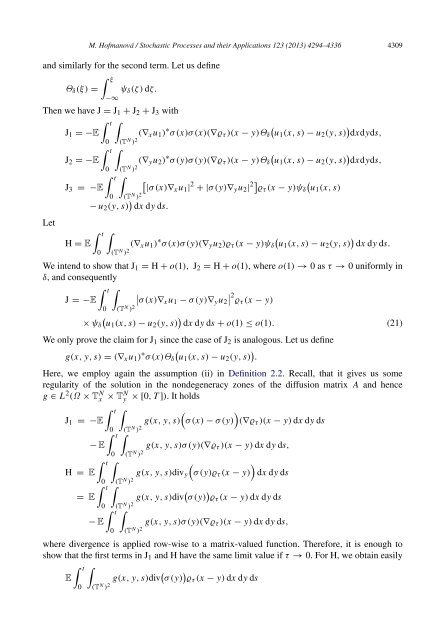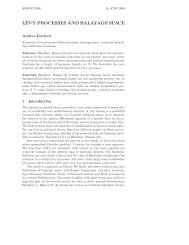Degenerate parabolic stochastic partial differential equations
Degenerate parabolic stochastic partial differential equations
Degenerate parabolic stochastic partial differential equations
You also want an ePaper? Increase the reach of your titles
YUMPU automatically turns print PDFs into web optimized ePapers that Google loves.
M. Hofmanová / Stochastic Processes and their Applications 123 (2013) 4294–4336 4309<br />
and similarly for the second term. Let us define<br />
Θ δ (ξ) =<br />
ξ<br />
−∞<br />
ψ δ (ζ ) dζ.<br />
Then we have J = J 1 + J 2 + J 3 with<br />
t <br />
J 1 = −E (∇ x u 1 ) ∗ <br />
σ (x)σ (x)(∇ϱ τ )(x − y)Θ δ u1 (x, s) − u 2 (y, s) dxdyds,<br />
0 (T N )<br />
2 t <br />
J 2 = −E (∇ y u 2 ) ∗ <br />
σ (y)σ (y)(∇ϱ τ )(x − y)Θ δ u1 (x, s) − u 2 (y, s) dxdyds,<br />
0 (T N )<br />
2 t <br />
<br />
J 3 = −E |σ (x)∇x u 1 | 2 + |σ (y)∇ y u 2 | 2 <br />
ϱ τ (x − y)ψ δ u1 (x, s)<br />
0 (T N ) 2<br />
− u 2 (y, s) dx dy ds.<br />
Let<br />
t <br />
H = E (∇ x u 1 ) ∗ <br />
σ (x)σ (y)(∇ y u 2 )ϱ τ (x − y)ψ δ u1 (x, s) − u 2 (y, s) dx dy ds.<br />
0 (T N ) 2<br />
We intend to show that J 1 = H + o(1), J 2 = H + o(1), where o(1) → 0 as τ → 0 uniformly in<br />
δ, and consequently<br />
t <br />
<br />
J = −E<br />
σ (x)∇ x u 1 − σ (y)∇ y u 2 2 ϱτ (x − y)<br />
0 (T N ) 2<br />
× ψ δ<br />
<br />
u1 (x, s) − u 2 (y, s) dx dy ds + o(1) ≤ o(1). (21)<br />
We only prove the claim for J 1 since the case of J 2 is analogous. Let us define<br />
g(x, y, s) = (∇ x u 1 ) ∗ σ (x)Θ δ<br />
<br />
u1 (x, s) − u 2 (y, s) .<br />
Here, we employ again the assumption (ii) in Definition 2.2. Recall, that it gives us some<br />
regularity of the solution in the nondegeneracy zones of the diffusion matrix A and hence<br />
g ∈ L 2 (Ω × Tx N × TN y × [0, T ]). It holds<br />
t <br />
<br />
<br />
J 1 = −E g(x, y, s) σ (x) − σ (y) (∇ϱ τ )(x − y) dx dy ds<br />
0<br />
(T N ) 2<br />
t <br />
− E g(x, y, s)σ (y)(∇ϱ τ )(x − y) dx dy ds,<br />
0 (T N )<br />
2 t<br />
<br />
<br />
H = E g(x, y, s)div y σ (y)ϱ τ (x − y) dx dy ds<br />
0<br />
(T N ) 2<br />
t <br />
= E g(x, y, s)div σ (y) ϱ τ (x − y) dx dy ds<br />
0 (T N ) 2<br />
t <br />
− E g(x, y, s)σ (y)(∇ϱ τ )(x − y) dx dy ds,<br />
0 (T N ) 2<br />
where divergence is applied row-wise to a matrix-valued function. Therefore, it is enough to<br />
show that the first terms in J 1 and H have the same limit value if τ → 0. For H, we obtain easily<br />
t <br />
E g(x, y, s)div σ (y) ϱ τ (x − y) dx dy ds<br />
0 (T N ) 2



